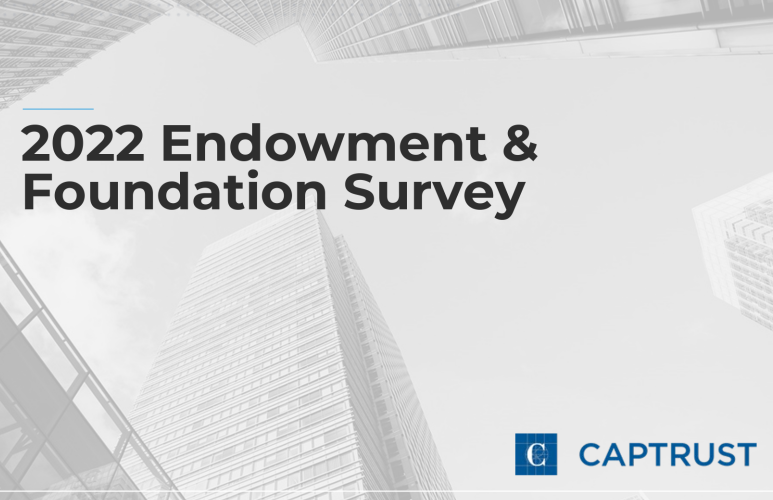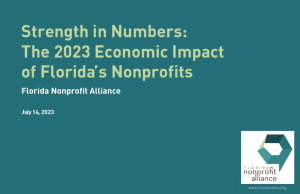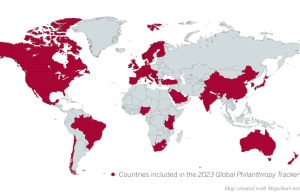Environmental, social, and corporate governance (ESG) investments are great when the returns are high, but board members start asking questions of foundation and endowment officers when returns are not great.
Those board members are expected to also be donors to foundations and more organizations are using an outsourced chief investment officer (OCIO) or discretionary investment management models to bolster returns.
These are some of the findings in the annual Endowment and Foundation Survey from CAPTRUST Financial Advisors (CAPTRUST). The largest percentage of the 169 respondents (45%) had investable assets of less than $25 million.
ESG, impact, and mission-aligned investing fell 1% during 2022 to 37%. The reduction continues a multiyear trend across most asset classes. Alternatives stand out as the exception, and more organizations are now identifying local impact investment opportunities to incorporate mission alignment into their portfolios.
Although the number of nonprofits allocating to ESG, impact, and mission-aligned investments decreased in 2022, most respondents (57%) expect the prevalence of these strategies to increase during the next five years. Only 11% believe the trend will recede.
The ESG responses were unexpected, according to James Stenstrom, director at CAPTRUST. “We were definitely surprised when we saw the numbers plateau,” he said. “When (portfolios are) underperforming people ask a lot of questions” and decisions on screening out investment areas are harder to defend, he said.
For example, the energy industry is often screened out of portfolios, but it had robust returns in an otherwise down market at the end of 2022.
The ratio of organizations that use negative screening — that is, excluding companies that do not align with their values — versus positive identification, defined as investing more in companies that align with their values, remains largely unchanged.
Rising donor interest in ESG might be part of this expectation. In 2022, 26% of nonprofits reported an increase in donor interest in these strategies, with only 3% seeing interest wane, according to the data.
Nonprofit managers not adopting ESG, impact, or mission-aligned investments increasingly cite real impediments, rather than education-related concerns, as their primary reason for not adopting these strategies.
For example, in 2022, the most common barriers were potential performance impact (32%) and inability to track specific impact (26%), compared to the lack of consideration (17%) and perceived complexity (17%) reported in 2021.
In 2022, ESG adopters were three times more likely than nonadopters to talk about the subject with their advisor. Surprisingly, 61% more nonadopters than adopters report discussing these strategies with their advisors.
Expressing Concerns
Leaders are also “extremely highly” concerned regarding market volatility (22%), inflation (20%) economic growth (11%) and return expectations (11%). That is keeping them in domestic equities, rather than international equities or alternative investments.
Changes to domestic and international equities reversed multiyear trends. Even with the increase to international equities — at the expense of domestic equities — investors still exhibit a strong home-country bias.
Nearly all of those surveyed (95%) have a formal investment policy and 96% have a formal conflict of interest policy. And, 87% have a separate finance or investment committee that oversees investable assets.
Alternative investments are lagging more than traditional investments, with 39% of the 169 foundation leaders responding to the survey not currently allocating to the asset class. Some 10% of respondents who are not investing in alternatives said they do not see a potential benefit, with 42% citing liquidity concerns as the primary objection.
Only 2% reported using cryptocurrency as an investment vehicle.
The proportion of respondents engaging an outsourced chief investment officer (OCIO) increased to 33% from 28% in 2021 and 24% in 2020.
Despite the growth of discretionary management engagements, most endowments and foundations continue to manage their investment assets either internally or with the assistance of an investment consultant.
While most nonprofit managers leverage their OCIO for portfolio implementation, security and investment manager selection is one of the least-provided services.
More than half of those surveyed (55%) tap board members for financial support. Every environmental or human services organization surveyed requires or expects board member contributions, while only 46% of religious nonprofits do the same. Most (57%) require between $1,001 and $10,000 and just 7% require more than $10,000.
An organization’s spending rate and expected return on portfolio assets hold almost no correlation, which according to Stenstrom, dispels a common myth about spending rate dictating investment goals. There are enough factors influencing financial policy design that it seems decisions around spending amounts and return targets are being made independently of each other, he said.
For some organizations, this lack of correlation is likely intentional. For others, the data might reflect poor internal coordination as last year’s survey found the investment committee and group in charge of budget and spending decisions overlapped in only 58% of organizations.
Organizations with net outflows — those that spend more than they fundraise — spend more than their budget 43% of the time, whereas organizations with net inflows — those that fundraise more than they outlay – spend more than their budget only 6% of the time, according to data in the report.
The full 36-page report can be downloaded at https://www.captrust.com/wp-content/uploads/2023/02/EF-Survey-2022-Final-FINAL.pdf








